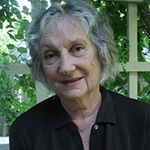Finding a Lost Cuisine: The German-Jewish Cookbook
Sept. 8, 2017
By Gabrielle Rossmer Gropman
I just finished a large batch of "krokerle" from "The German-Jewish Cookbook." When chopping the hazelnuts, I automatically went to my mezzaluna, called a "wiegemesser" in German, that antique wood-handled steel half-moon knife that chops expertly. Halfway through this exercise I realized — "Wait a minute, why am I not using my Cuisinart?" Why, indeed?
 Most likely, co-authoring this book with my daughter, Sonya, and immersing myself in the history of this cuisine, I connected to the time and place where these cookies originated, where Cuisinarts didn’t exist yet. Besides, the mezzaluna satisfies with a sense of control over each chop.
Most likely, co-authoring this book with my daughter, Sonya, and immersing myself in the history of this cuisine, I connected to the time and place where these cookies originated, where Cuisinarts didn’t exist yet. Besides, the mezzaluna satisfies with a sense of control over each chop.
The recipe comes from one of our favorite elders, Herta Bloch, and we recount in the cookbook the not-so-successful first time we made them together. She was 92 at the time and we visited her small apartment in Washington Heights, New York.
"We are here to learn how to bake Krokerle — the untranslatable name alone piqued our interest. It is a cookie that is unique to her German-Jewish family, though we could see it resembles the numerous spicy German cookies that are eaten during the Christmas season. It was baked by her mother and exists in Herta's archive of family recipes. We are surprised, and find it hilarious when Herta says, 'I have never made these cookies before.' We are here to learn from the wisdom of an old master, only to discover it is her first time! On second thought, we realize it is great, as is adds to the living quality of the food that the 'old-timer' is learning to make her mother's recipe for the first time, because of our visit."
Eventually, we perfected the recipe with Herta’'s daughter Marion who learned from her grandmother. The expertise on this particular recipe appeared to skip a generation. While we didn't learn the best way to make the krokerle that day, we still learned so much from Herta's fluid movements in the kitchen and from her knowledge of the deep traditions of the culture we were exploring. She was both a traditional and modern woman all at once. She worked alongside her husband, Alfred, in Block and Falk, their kosher butcher and sausage shop until it closed in the mid 1990s. Everyone in the community came there to buy sausages and smoked meats.
So, here is our new cookbook. We wrote this book to preserve and document the cuisine of a nearly vanished culture.
In a wonderful review this week in Tablet Magazine, Leah Koenig wrote, "It is hard to overstate the importance of a book like 'The German-Jewish Cookbook,' which the Gropmans hope to have translated into German. It captures a lost moment in time, elevating a rich history and culture that, within a generation, will have almost no one left who experienced it."
Koenig captured our myriad reasons for writing. When I go back to Germany, the Jews of German origin aren't there anymore. The history of the expulsion is there, but what came before is not. This was something we needed to do.
 Gabrielle Rossmer Gropman, Brandeis ’59, is the co-author, with her daughter Sonya Gropman, of "The German-Jewish Cookbook: Recipes and History of a Lost Cuisine," published in the HBI Series on Jewish Women.
Gabrielle Rossmer Gropman, Brandeis ’59, is the co-author, with her daughter Sonya Gropman, of "The German-Jewish Cookbook: Recipes and History of a Lost Cuisine," published in the HBI Series on Jewish Women.